Each year, the Sustainability Round Table Booklist Committee curates an annual list of 10 notable children’s books on nature, conservation, and communities that reflect the mission of SustainRT “to exchange ideas and opportunities regarding sustainability in order to move toward a more equitable, healthy, and economically viable society.” Click below to download the formatted list!
Category: Articles, Books, etc…
Sustainability Book Review: How to Prepare for Climate Change
As a reoccurring feature on the Sustainability Roundtable blog, we will post reviews of books related to sustainability. Interested in submitting your own review to the blog? Contact August at aolundsmith@gmail.com.
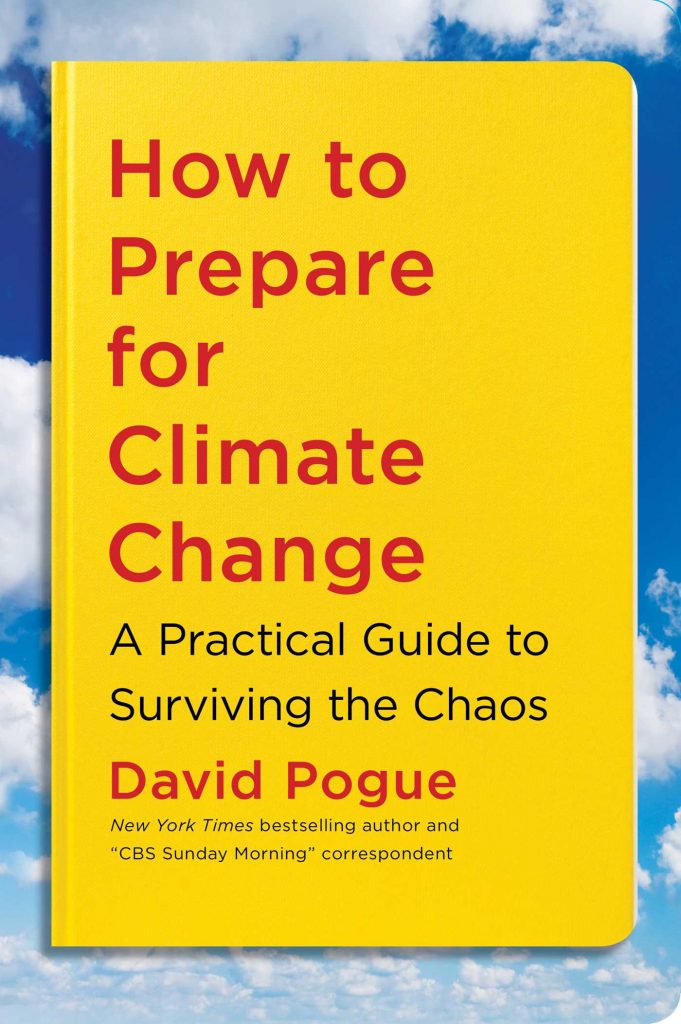
How to Prepare for Climate Change: A Practical Guide to Surviving the Chaos by David Pogue
Book Review by Kacper Jarecki
This book was released just recently so I wanted to take a look. First of all, a note about the author David Pogue. He is a correspondent on CBS Sunday Morning and NOVA on PBS. He is the author of books such as Mac Unlocked, Windows 10: The Missing Manual, Opera for Dummies, Magic for Dummies, Pogue’s Basics: Life, and a bunch more. David Pogue definitely seems to have a lot of diverse interests and his career doesn’t solely focus on sustainability. That being said, he does bring some unique perspectives and interesting suggestions for how to survive in different catastrophic situations. Some chapter titles include Preparing for Flood, Preparing for Drought, and Preparing for Hurricanes and Tornados.
This is a book that you don’t necessarily read straight through: each chapter stands on its own so you can read whatever topic interests you at the moment. There is a chapter about the best places to live with coastal cities like NYC where I live, not being ideal with rising sea levels. There is a list of the top 15 cities that will be least affected by global warming in the US: with Madison, Wisconsin taking the number 1 spot – 5 lakes, 260 parks, 11 beaches, and 200 miles of hiking and biking trails. Portland, Oregon is on the list too – and that is the site of the PLA (Public Library Association) Conference in March 2022, so I hope I can go to the conference and take a look around in the city J There are also chapters about how to build your home so that it withstands different catastrophes better, where to invest your money, and what plants to grow in your garden.
David Pogue gives a lot of suggestions including many out of the box ones. For example, there is a section about whether or not to have kids: being child-free keeps “9,400 tons of carbon dioxide out of the atmosphere,” but additionally also frees up time to “work on the planet’s behalf.” He lists what to have in an emergency bag, including cigarettes because if you’re a smoker because “the last thing you need is the stress of withdrawal when you’re living through trauma.” And he says applying antiperspirant to the back of your neck will help keep cool in the summer. He even recommends that atheists join a local church or temple, if at the very least to cultivate a supportive social network.
As evidenced by the past year with the pandemic, we are definitely living in some special times. It’s helpful to think and plan about different possible situations that may come up in our lifetime. How to Prepare for Climate Change definitely gives a lot of food for thought.
Discussion Questions:
1. What are some possible ways climate change can affect your current living area?
2. If you could live anywhere in the world, where would you live? What are some features that are important to you (i.e. living by the beach, being next to a park, etc.)?
3. What are some things you can do right now to get prepared in case of an emergency?
4. Which of David Pogue’s suggestions stood out to you the most?
5. Do you have any tips for surviving a catastrophe that you’d like to share?
Sustainability Book Review: Music for Tigers
As a reoccurring feature on the Sustainability Roundtable blog, we will post reviews of books related to sustainability. Interested in submitting your own review to the blog? Contact August at aolundsmith -at- gmail.com
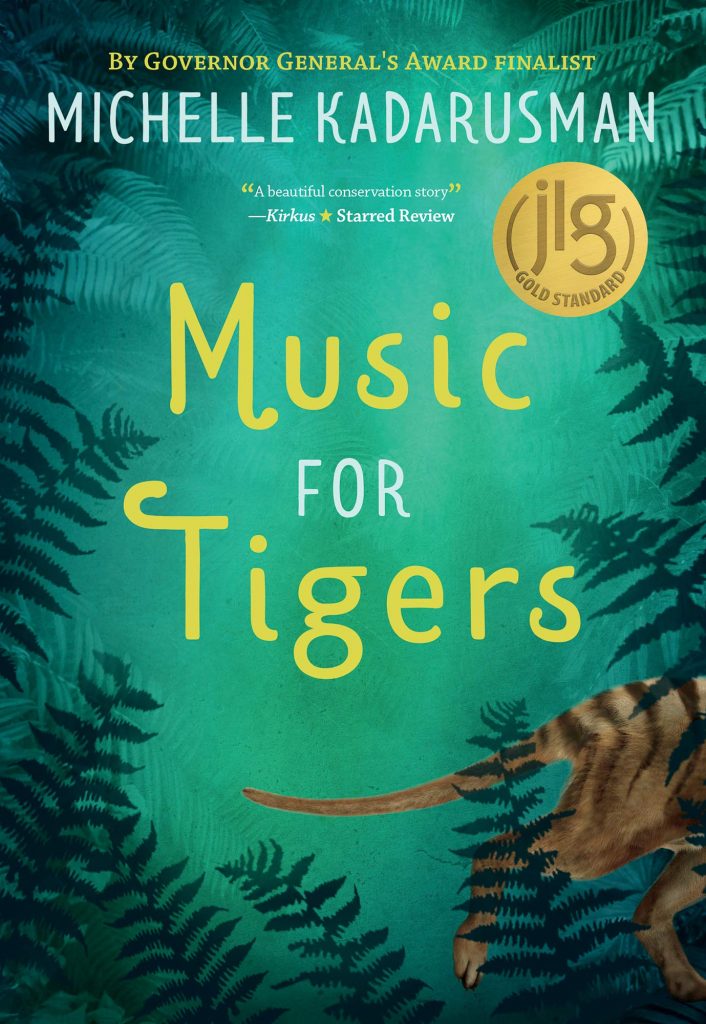
Review: Music for Tigers by Michelle Kadarusman
Reviewed by Angele DeNeve, Assistant Manager Queens Library at Peninsula
Spoiler Alert: This review talks about the ending of Music for Tigers.
How could logging, mining and conservation possibly be connected to music and tigers? Luisa, a 12- year-old musician from Canada, is sent across the world to spend time with her uncle in the Tasmanian Rainforest. The land belonged to her ancestors and, unbeknownst to her, is being taken over to create easier access for logging and mining of its natural resources.
Luisa is disconnected from nature and completely unaware of the human effect on the Tasmanian Rainforest. Upon arrival, her only concern is finding time to practice for her upcoming audition for the Toronto Symphony Youth Orchestra. However, after spending time in the rainforest, getting to know her family’s history and meeting indigenous people of the area, Luisa’s focus begins to shift to the injustice of the loss of her family’s land to mining industries and the damage the mining is doing to the rainforest and its inhabitants. In particular, Luisa learns of the local “tigers,” or Tasmanian tigers believed to be extinct.
As the days pass Luisa learns of her family history through the journals of her great grandmother and discovers her connection to the land. After spending time with Colin, a local boy with autism who is an expert on environmental and local history, Luisa learns about the rainforest, the extinction of species, the history of the land and how to survive in the wilderness. She also makes the connection that people who don’t understand autism spectrum disorder can misunderstand and mistreat people who fall on the spectrum. Once Luisa is informed, she becomes sympathetic to her friend and defends and protects him from others. Similarly, once she is educated about the Tasmanian Rainforest, she feels compelled to do what she can to improve the situation.
While Luisa can’t save the land from the mining industry, she can help to protect the Tasmanian tigers using her music. Luisa’s music, like her great grandmother’s music, connects her to the last surviving Tasmanian tiger, enabling the safe capture and relocation of the animal before the land is taken over. Luisa not only saves the tiger, makes a friend and broadens her mind, but the experience helps her to succeed at her next audition. After being so focused on one thing for so long, Luisa sees that opening herself up to new experiences makes her a better human being and a better musician.
I appreciate that this story was set in an unusual place, with unusual species and carries such powerful messages about conservation, empathy, and personal growth. The most prevalent lesson being that once you learn about any type of mistreatment (land, species, human or otherwise) and see its impact first hand, it becomes your duty to respond. Most importantly, watching Luisa use her talents to make a change is a wonderful lesson on the effect one person’s actions can have on the world around us.
Extension activities for librarians working with youth:
- Have children locate the Tasmanian Rainforest on a map and find one recent article relating to the rainforest.
- Begin family history projects where children research their roots going back as many generations as possible – highlighting marriages, moves and career paths that impacted future generations.
- Research a Tasmanian aboriginal person. Share information in group discussions or poster projects.
- Research an endangered or extinct species and find the contributing factors to its downfall.
Top 10 Sustainability-Themed Children’s Books

Each year, the Sustainability Round Table Booklist Committee curates an annual list of 10 notable children’s books on nature, conservation, and communities that reflect the mission of SustainRT “to exchange ideas and opportunities regarding sustainability in order to move toward a more equitable, healthy, and economically viable society”. Check out the 2021 list today by clicking here!
We’re also excited to share the responses of two authors to their books’ inclusion on the 2021 list. Brooke Smith, author of The Keeper of Wild Words, wrote:
I’m so honored to have my book The Keeper of Wild Words chosen as one of the top 10 sustainability themed children’s books of 2021. One of the definitions of sustainability is to endure. To endure is to live on, remain in existence, last. When I found out that the Oxford Junior Dictionary was removing over 100 natural words from its pages because they no longer felt they had relevance for today’s children, I knew I needed to do something. I wanted to help make sure that these wild words live on for future generations. If the language of the natural world disappears, how will we know what to protect? To love? To cherish? Our children have been handed a world that is in a state of crisis in many ways. As a writer I’m determined to give them what I can…a story that celebrates the natural world and all of these beautiful words, so they can always be remembered.
Lindsey Carmichael, author of The Boreal Forest, wrote:
I am absolutely thrilled that The Boreal Forest has been chosen as one of the best sustainability-themed children’s books for 2021! The boreal biome provides lumber and paper and food and traditional medicines, making it an important natural resource. Even more important are the roles the biome plays in the water cycle, the carbon cycle, and in maintaining biodiversity. Unless the boreal forest is used sustainably, in ways that support recovery and resilience, the consequences will be global and severe. To me, that’s what sustainability is all about: recognizing that plants, animals, people, and the Earth’s land, water, air, and climate are all interdependent. Building respect and a sense of wonder towards the natural world supports sustainable action—and I really hope that this book helps kids see the boreal forest and all its creatures for the wonders they truly are.
Check out The Keeper of Wild Words, The Boreal Forest, and all of the other wonderful books included on the 2021 list, from your local library today!
Sustainability Book Review: Nature’s Best Hope
As a reoccurring feature on the Sustainability Roundtable blog, we will post reviews of books related to sustainability. Interested in submitting your own review to the blog? Contact August at aolundsmith@gmail.com.
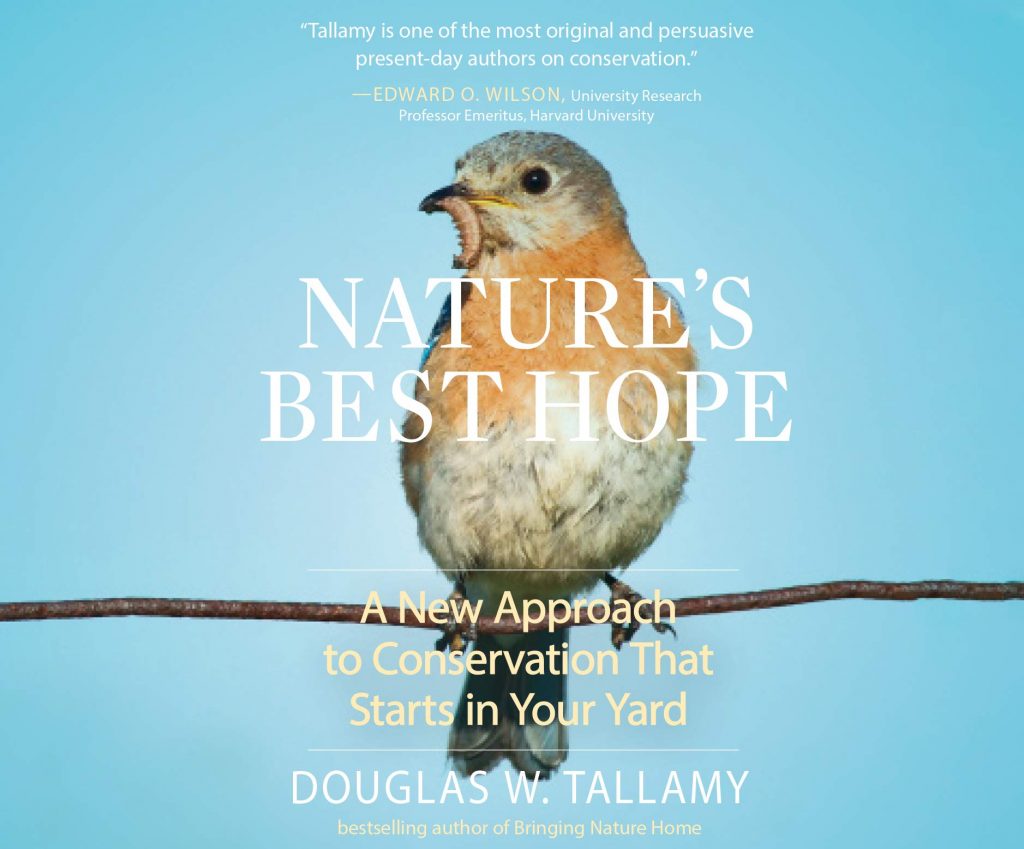
Nature’s Best Hope: A New Approach to Conservation That Starts in Your Yard by Douglas W. Tallamy (Timber Press; 2020)
Book review by Mary Callahan, Children’s Librarian, Hunters Point Library Environmental Education Center, Queens Public Library, NY
I hate gardening. Although I love the idea of growing plants and flowers, my allergies turn the actual work of planting and weeding into eye-itching, nose-dripping, sneezing-inducing misery. But after reading Nature’s Best Hope by Douglas W. Tallamy, I am already plotting out the new native-plant garden that will replace half my front lawn this spring.
That’s because Tallamy, a professor of entomology and wildlife ecology at the University of Delaware, provides a concrete response to the question asked by many people who are concerned about conservation, habitat loss, and the increasing rate of extinction: What can I do?
It turns out there’s a lot you can do.
Tallamy takes the issue of conservation out of the realm of government or national organizations and into the scope of the individual, particularly individual landowners. It’s not enough to preserve natural habitats and fight extinction in protected parks and preserves, he argues. As important as these places are, they are too small and separated from one another to protect species in the long run. People must create a space for nature—insects, birds and other animals, and the plants that they need to survive—literally in their own backyards. And in their front yards, too.
To accomplish this, Tallamy proposes shrinking an all-American symbol—the green, manicured grass lawn. We must replace turf grass, which supports virtually no life, with native plants that are the foundation of a healthy habitat, he insists. If all American landowners made it a goal to convert half of their lawn to “productive native plant communities,” it would restore “some semblance of ecosystem function to more than twenty million acres of what is now ecological wasteland,” a space bigger than the combined areas of the Everglades, Yellowstone, Yosemite, Grand Teton, Canyonlands, Mount Rainier, North Cascades, Badlands, Olympia, Sequoia, Grand Canyon, Denali, and Great Smoky Mountains National Parks.
The result would be, in effect, the country’s largest park system, which Tallamy has dubbed “Homegrown National Park.” This network of private-yard habitats would not only provide food and shelter to the creatures that are being denied a place to live by human development, it would also create “biological corridors” between larger nature preserves, providing a way for animals to move when faced by food shortages, over-population, or other threats. Tallamy writes, “Envision your property as one small piece of a giant puzzle, which, when assembled, has the potential to form a beautiful ecological picture.”
Tallamy understands that Americans love their lawns, and he acknowledges and addresses objections in a style that is direct, conversational, and at times exasperated. He devotes the last chapter of the book to answering potential questions about his approach, covering everything from Lyme disease to homeowners-association regulations.
In addition to making his theoretical case, Tallamy, who also wrote Bringing Nature Home: How You Can Sustain Wildlife With Native Plants, provides lots of useful information and resources for those (like me) who would like to help make Homegrown National Park a reality. For instance, just replacing grass with petunias and impatiens is not enough, gardeners may be dismayed to learn. Many insects need specific plants to survive, and they are not the imported ornamental plants that are the mainstays of American yards. That means replacing manicured lawns with plants that are commonly considered weeds. Monarch butterflies, whose numbers are diminishing at an alarming rate, must have milkweed and nothing else will do.
Among Tallamy’s other (very doable) recommendations for property owners: remove invasive plants, “treasure your leaf litter,” avoid insecticides and herbicides, and don’t mow in the evening, to protect nocturnal species.
For city dwellers who have no grass to convert, Tallamy points out that the lawns of schools and other public properties could also be transformed into native plant gardens by committed community members. He doesn’t specifically mention libraries in this context, but some libraries have already embraced this challenge. An article about library butterfly gardens appears in the Trends section of the March/April 2021 issue of American Libraries. Nature’s Best Hope makes a persuasive case that all of us—libraries included—have a part to play.
Discussion questions:
- Do you think the idea of a Homegrown National Park is viable? How could individuals help make it a reality? What are some roadblocks?
- How can city dwellers and others with no private outdoor space contribute to this approach?
- What specific role can your library play in creating Homegrown National Park?
Sustainability Book Review: The Nature of Nature
As a reoccurring feature on the Sustainability Roundtable blog, we will post reviews of books related to sustainability. Interested in submitting your own review to the blog? Contact August at aolundsmith@gmail.com.
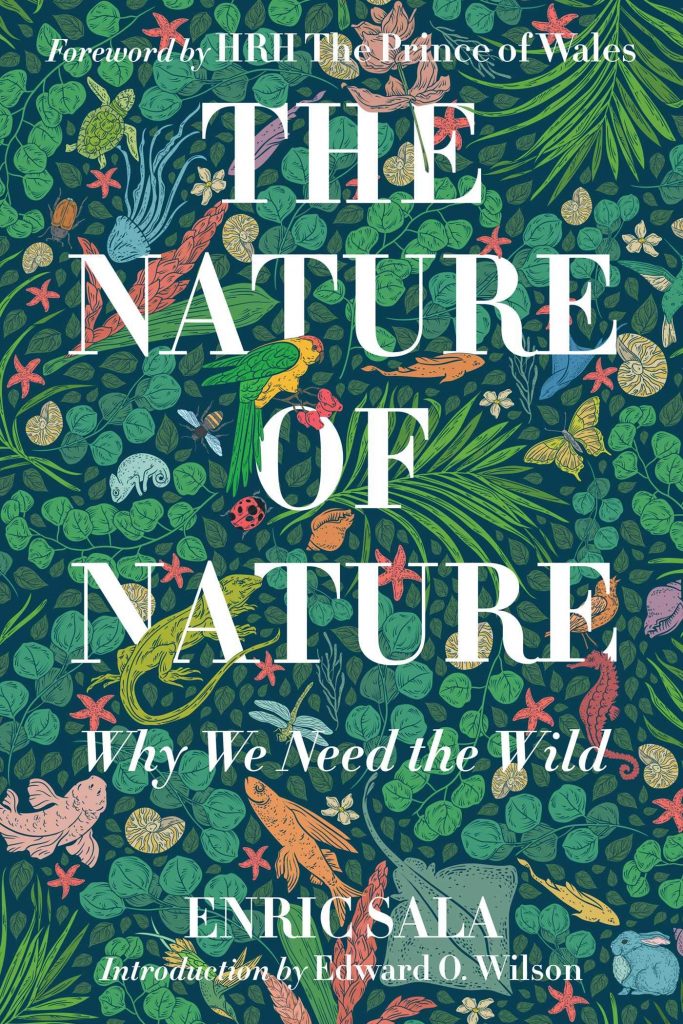
The Nature of Nature: Why We Need the Wild by Enric Sala, National Geographic, 2020.
Reviewed by Rachel Sperling
Chapter Twelve of The Nature of Nature: Why We Need the Wild is called “The Moral Imperative,” and in it, author Enric Sala describes how he and his team of researchers and conservation advocates communicate with world leaders and policy makers, to convince them that the natural environment – “the wild,” as Sala puts it – is worth saving. He does so not by barraging his audience with charts and graphs full of complicated data – not at first, anyway – but by showing them just what they stand to lose if serious efforts to stem biodiversity and habitat loss are not taken. In this chapter, Sala describes taking President Ali Bongo Ondimba of Gabon out on his expedition vessel in 2002, and allowing him to pilot the vessel’s remotely operated vehicle, “a submersible robot tethered to the ship and armed with a camera that allows one to watch the underwater world in real time”. Sala goes on to describe President Bongo Ondimba’s reactions, including his sudden connection with the world below the waves, and his growing understanding that these waters off Gabon’s coast need to be protected.
Though it occurs late in the book, the moment stands out because it’s a good illustration of a couple of Sala’s overarching themes: humans are part of the global ecosystem, and if we better understood our place and the effects of our actions, we might change our policies and behaviors. Sala’s writing is accessible to scientists and non-scientists alike; using plain language and clear, relatable examples, he explains how ecosystems function, how small changes – such as the removal of one species – can have devastating consequences, and why biodiversity is a good thing for everyone. The final chapter – added just prior to publication – deals with COVID-19, which is fitting because zoonotic viruses like COVID-19, H1N1, and SARS, are a result of human exploitation of nature.
One aspect I do wish that he had touched upon is the future of those people whose livelihoods would be impacted by more sustainable practices. While the moral imperative – to use Sala’s phrase – is clear, it’s an important issue and one that needs to be addressed. That said, in this slim volume, Sala makes his argument effectively and I recommend this book strongly to anyone who is interested in clear, concise science writing, particularly on the subjects of biodiversity, and human impact on the global ecosystem.
Enric Salas received his B.Sc. from the University of Barcelona in 1991, and his Ph.D. from the University of Aix-Marseille II in 1996. A former university professor, he is currently a National Geographic Explorer-in-Residence. You can find his filmography and a list of his other publications here: https://en.wikipedia.org/wiki/Enric_Sala
More on National Geographic Explorers: https://www.nationalgeographic.org/projects/explorers/
Topics for discussion:
- Sala describes meeting with important heads of state, to help them see the importance of the wild. What are some ways that ordinary people, especially those that live in cities and perhaps lack the means to travel, can share equivalent experiences? Are there programs that bring people to the wild, or bring the wild to people?
- Think about the ecosystem(s) you inhabit or are close to. How many different species can you name, and can you describe the role(s) they play? Can you identify foundation species, or keystone predators?
- In chapter five, Sala questions the accuracy of GDP in measuring the maturity of a human society, and proposes the Environmental Maturity Index (EMI) instead. Is the EMI a better assessment tool? What are some other ways we might measure a society’s developmental maturity, especially as it relates to environmental health?
Sustainability Book Review: The Shallows and Trick Yourself to Sleep

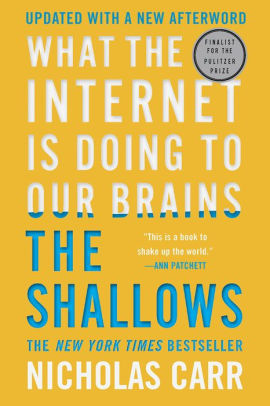
As a reoccurring feature on the Sustainability Roundtable blog, we will post reviews of books related to sustainability. Interested in submitting your own review to the blog? Contact August at aolundsmith@gmail.com.
The Shallows: What the Internet Is Doing to Our Brains by Nicholas Carr
and Trick Yourself to Sleep by Kim Jones
Book Reviews by Kacper Jarecki
Since it’s the holidays and everything, I thought that I would give a big treat by writing a double-book review! If you’re like me, you’ve been spending a ton of time on the computer, with meetings, workshops, webinars, and yes, more meetings, right? In fact, if you’re reading this, you’re on the computer, right now, I can tell!
So I came across this book, The Shallows, and it interested me because it talks about how computers and phones are changing not just our way of life, but our minds too! Every new technology changes us in some way, including plain old-fashioned books. When books first came out, nearly everyone was reading them out loud, and the author, Nicholas Carr, mentions that reading silently was considered a new innovation for the time. However, now “we are devoting much less time to reading words printed on paper” (p. 88).
Although we have more information available than ever, our attention is more scattered than ever before and constantly jumping from one push notification to another. Americans are spending half their time looking at screens. The author states, “the more distracted we become, the less able we are to experience the subtlest, most distinctively human forms of empathy, compassion, and other emotions” (p.221). What is missing now is time to stop and reflect and focus. However, the author notes that nature has important restorative properties, and that people even looking at “pictures of nature were able to exert substantially stronger control over their attention” (p.220).
So, talking about the internet, often I’ll stay up late looking at my phone screen and before I know it, it’s super late and I don’t even know what happened! So I read this book, Trick Yourself to Sleep for tips on how to sleep better. This book is easy to read, with 222 way to fall asleep. In fact, this author recommends setting an alarm clock for 2 hours before going to bed, to just relax and get in the mood for sleeping! And one great way to relax is… drumroll please… reading! “When the stress hormone cortisol in each individual’s blood was measured, it was discovered that the readers’ level had dropped the most – by 68%” (p.11). Reading a book before bed is one of the best ways to decompress; however, the author also mentions that listening to a bedtime story is also great! Some other tips: a lavender smell is great to have at night-time, smiling in bed to make yourself happier and less worried, and thinking of 5 ways your day went well.
The first step to sustainability is taking care of your health. So if you’re reading this, shut off your computer and go for a walk in nature instead, and then read a book! Good luck!!! Happy New Year!!!
Discussion questions:
1. Do you feel like you spend too much time online?
2. What time do you usually go to bed? Are you satisfied with your rest?
3. Do you have any resolutions for New Year?
4. What are some things you do for self-care?
5. How do you plan to stay in touch with nature in 2021?
Sustainability Book Review: A Field Guide to Climate Anxiety
As a reoccurring feature on the Sustainability Roundtable blog, we will post reviews of books related to sustainability. Interested in submitting your own review to the blog? Contact August at aolundsmith@gmail.com.
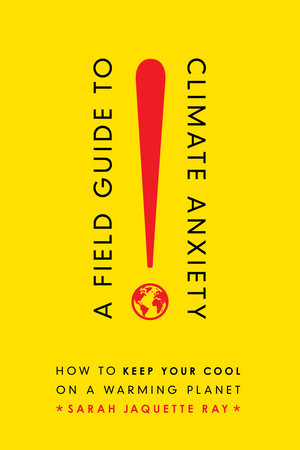
A Field Guide to Climate Anxiety: How to Keep Your Cool on a Warming Planet by Sarah Jaquette Ray, University of California Press, 2020
Review by Beth Filar Williams
Dr. Sarah Jaquette Ray, a professor of environmental studies at Humboldt State University, wrote this book after realizing that her students could not even envision a positive livable climate-changed future from the results of collective effort of many. Not because these students / this generation are lazy or do not care – more so they DO care but feel powerless and are constantly bombarded with all that is wrong and seemingly unfixable, handed to them from the older generation. Why should they even try when it’s not possible to get a positive end game? Frozen by fear, guilt or grief, how can anyone even imagine a desired future?
She begins the book speaking to the youth of today, naming their shared characteristics (like caring about social justice and climate change, two things that are linked); the financial insecurity they have beyond what any other generation has faced; the growing disparity between the rich and everyone else and also that they are the more ethnically diverse as a generation than any other generation before them. Even conservatives in Gen Z care about climate justice, unlike older generations in general. Dr. Ray wrote this book to help us combat climate change and injustice while grappling with feelings of powerlessness and despair. Ray offers strategies for climate justice activists to avoid burnout, pulling together works of adrienne maree brown’s emergent strategy, Per Epsen Stoknes’s Five Ds, Bob Doppelt’s transformational resilience, Rebecca Solnit’s justice work, and Glenn Albrecht’s solastalgia, just to name a few.
This book can be read linearly or non-linearly by picking any chapter. Starting with happiness and how you really find it in life to mindfulness to cultivating climate wisdom helps set a tone that is not found in many climate change books. Keys in this book are to find pleasure in the work, slow down and be mindful, remember this is not a new crisis, find what you can do well and do that part, it takes a community, and you need to be able to dream of desires and envision a possible future!
Though written for Ray’s college students, this “existential toolkit for action” is also great for anyone who wants to do something about the climate crisis but struggles with anxiety when faced with the dire predictions of climate scientists. A fabulous read for a book club. Not really long, written for nonscientists, and each chapter has bullet points that would be great reflection questions or turned into discussion topics.
A few discussion questions
- How do you experience or observe the role of emotions in climate justice work?
- The heart, the hand, and the head are all needed for sustained engagement. What are the effective implications of the content you are daily exposed to?
- Write your own manifesto. Why do you care about the planet, the suffering, and what are you skilled or passionate about that you can do? This can be an activity for reflection/writing/sharing.
Related resources:
Teaching Climate Change: Two Insights by Sarah Jaquette Ray
Sustainability Book Review: Our House is on Fire
As a reoccurring feature on the Sustainability Roundtable blog, we will post reviews of books related to sustainability. Interested in submitting your own review to the blog? Contact August at aolundsmith@gmail.com.
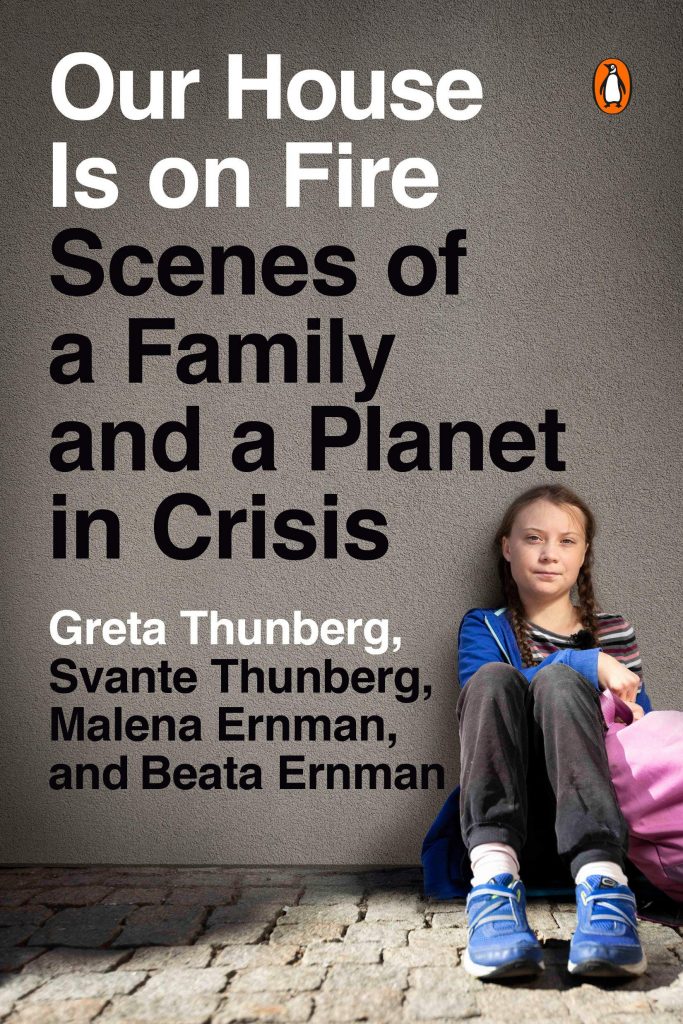
Review: Our House is on Fire: Scenes of a Family and a Planet in Crisis by Greta Thunberg, Svante Ernman, Malena Ernman and Beata Ernman
Reviewed by Angele DeNeve, Children’s Librarian at Queens Library at Glen Oaks
How does a 15 year-old girl with Asperger’s Syndrome, obsessive compulsive disorder, selective mutism and a severe eating disorder become a world renowned climate activist? Our House is on Fire: Scenes of a Family and a Planet in Crisis offers a raw and honest look at Greta Thurnberg’s family and their personal struggles leading up to the now famous school strike for the climate in August 2018. Readers get a look at the whole family, which sets the scene for their impassioned outrage at the lack of positive change in our planet’s rapidly increasing carbon emissions.
Greta’s mother, famed opera singer Malena Ernman, already an activist in her own right, fought for human rights, equal rights and the humane treatment of refugees. But it wasn’t until Greta saw a film about climate change that she and her family began to change their awareness of climate issues and made the decision to fight for our climate. In their research they learned that Sweden, their home, was one of the worst offenders in carbon emissions responsible for one of the largest ecological footprints in the world. “If everyone in the world were to live like Sweden it would require 4.2 planet earths.” They began to look at their own lives to make changes like buying an electric car, becoming vegan and completely stopping all airline travel after realizing that air travel is one of the biggest contributors to carbon emissions. They quickly understood while these changes were important, they would not be enough.
In the thirty years since the world was educated about the greenhouse effect and the damage we are collectively doing to our planet, nothing has changed. Our efforts have not reversed, or even slowed down our carbon emissions. In truth, they continue to steadily rise each year. More ice is melting, more forests are disappearing, more species are becoming extinct and oceans are becoming polluted. Sweden, which partially inhabits the arctic circle, provides a concrete example of how rapidly climate change is affecting nature and our planet. After visiting northern Sweden, Greta and her father saw firsthand the impact our carbon emissions are having on nature. The crisis was evidenced by the change in temperature, the shifting geography of the boundaries of forest and ice, and the movement of wildlife to accommodate the changes in temperature and vegetation.
Greta explains to readers that nothing is changing because “we are in a crisis that has never been treated as a crisis”. But that is exactly what it is. A climate crisis. She blames politicians; politicians who say carbon emissions must be reduced but never do anything to reduce them. Greta blames the media, calling them a total failure, for neglecting to put climate issues in the headlines and making the crisis known. Our time to correct the planet’s carbon emissions is running out. Without taking drastic measures the climate crisis will soon become irreversible.
While the story centers around the climate crisis, it also highlights the rise of mental illness in young girls which has directly affected their family with both Greta and her sister Beata being diagnosed with multiple disorders. In Sweden, mental health issues in children 10-17 years old increased over 100 percent in 10 years. While the family sheds light on their personal struggles, they also draw connections between climate change and the rise of mental health issues, climate change and the disparity between wealthy and poor countries, climate change and the tragedies that extreme weather have caused. Suggesting that these connections, which the majority of the population probably don’t think about, be explored further.
After being immersed in this family’s story and their passion for change, readers will undoubtably be educated about the climate crisis and hopefully be inspired to make changes in their own lives. Personally, I learned a great deal about climate change, the science and the politics behind it, and the leaders in the field, but I was mostly impressed by Greta. Her vast knowledge on the subject, her conviction for the health of our planet, and her remarkable ability to overcome personal adversity to fight for something she cares about while rallying others to support her cause are tremendous accomplishments. Greta gives me hope.
- Were you surprised, like me, to hear that in the 30 years since we learned about climate change we have not been able to reduce our carbon emissions at all?
- How much did you know about Greta Thurnberg before reading this? Have you read or listened to any of her speeches? Did you know anything about her personal mental health struggles? (Find Greta’s Ted Talk on Youtube here: https://www.youtube.com/watch?v=EAmmUIEsN9A )
- Can you think of ways that libraries can bring awareness of this issue to the public right now (virtually) in their communities?
Sustainability Book Review: Poisoned Water
As a reoccurring feature on the Sustainability Roundtable blog, we will post reviews of books related to sustainability. Interested in submitting your own review to the blog? Contact August at aolundsmith@gmail.com.
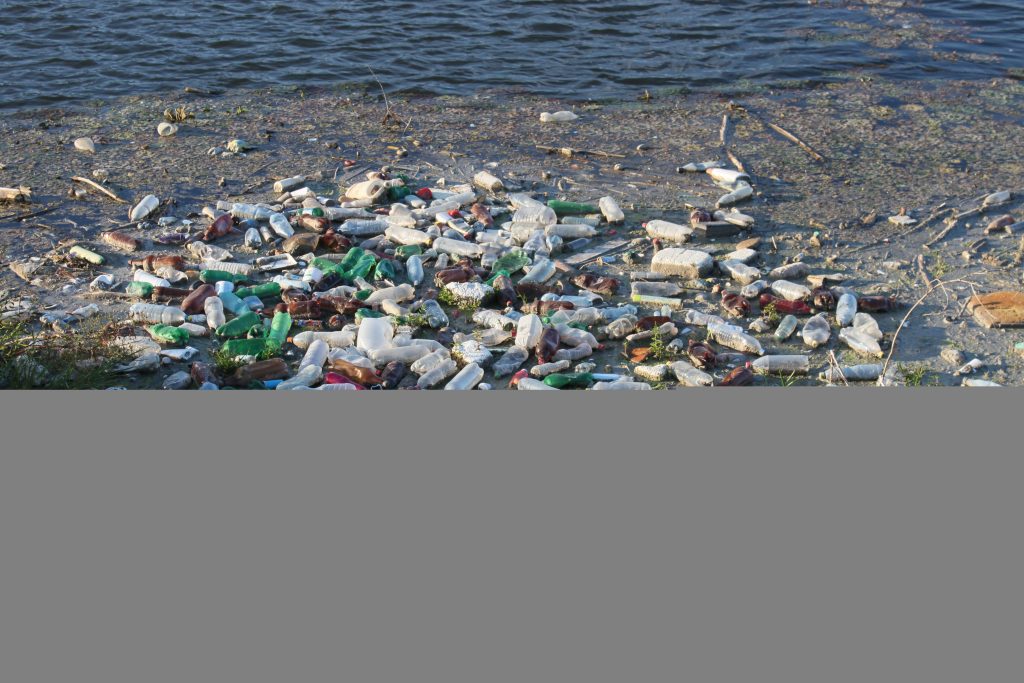
Review: Poisoned Water: How the Citizens of Flint, Michigan, Fought for Their Lives and Warned the Nation by Candy J. Cooper and Marc Aronson (May 2020; Bloomsbury Children’s Books).
Submitted by Mary Callahan, Queen Public Library
At a time when conversations about systemic racism are taking place across the country, Poisoned Water: How the Citizens of Flint, Michigan, Fought for Their Lives and Warned the Nation by Candy J. Cooper and Marc Aronson is a reminder that environmentalism cannot be extricated from the quest social justice.
The source of the water that gives this book its title was indisputably the polluted Flint River, but, as this book clearly describes, the environmental issues of the Flint water crisis were inextricably linked to issues of race and class.
‘The book has been labeled “for young readers” (ages 10-17) by its publisher, but its subject matter seems more suited to teens than younger readers. In fact, adults looking for a straightforward and engaging overview of the story will find it here. In clear prose, the authors document the events and decisions that led to the water crisis in Flint Michigan and the ways in which the city’s residents—many poor and people of color—struggled to have their concerns about the city’s polluted water supply addressed.
The decision to change Flint’s water supply from Lake Huron to the Flint River had its roots in the economic disaster created by massive layoffs at General Motors, the company that was responsible for the growth of Flint and the source of its nickname, the Vehicle City. In 2011, the city, in massive debt, was placed under the supervision of a series of governor-appointed emergency managers whose primary focus was saving money. The water crisis began as a cost-cutting plan. For the preceding 50 years, Flint’s drinking water was taken from Lake Huron and processed and piped in from Detroit. But as Detroit’s water rates increased, Flint officials decided to save money by creating a new pipeline that would deliver water directly from Lake Huron to the Flint, bypassing Detroit. During the two to three years the new pipeline was being built, Flint’s water would come from the Flint River.
The switch occurred in April 2014. In the ensuing year and a half, polluted river water, further tainted by the city’s improper chemical treatment and aging water pipes, poisoned thousands of Flint children with lead, resulted in an outbreak of Legionnaires disease, and caused countless other health ailments. But while Flint residents raised their concerns about the water almost immediately, the water supply was not switched back to Lake Huron for 18 months—until October 2015—and the effects on the city’s water system and its residents still linger.
Cooper, a journalist and Pulitzer Prize finalist, conducted extensive research into public records, news accounts, and emails. But the story is primarily focused on the experiences of city residents who tried to get city, state, and federal officials to address the problem. The indifference of the local officials is mind-boggling: although they were repeatedly presented with samples of off-color, foul-smelling water; with tests revealing high lead levels; and even with clear evidence that the water corroded metal parts at a GM factory, they refused to admit the water posed a danger to people. (Eventually GM arranged to get its water from Lake Huron, but the city would not do the same for the residential water supply.)
Poisoned Water is a testament to the power of grassroots activism. It recognizes, in particular, the leadership positions played by many people of color in Flint. These leaders, the authors note, were often overlooked in earlier reports on the Flint water crisis. As Curt Guyette, a journalist who covered the water crisis story for the ACLU notes, “A lot of people who were never before at the same table came together and worked together really effectively to bring this crisis to the attention of the world.” He added, “It was the residents who saved themselves. That’s the really inspiring aspect of this story… We can save ourselves.”
As much about government mismanagement as it is about water pollution, Poisoned Water draws a timely connection between the environmentalist and social justice movements. As co-author Marc Aronson said in an interview with Publishers Weekly, “As we think about preserving the Earth and our relationship with it, we shouldn’t separate concerns of environmentalism and ecology from the power structures in our world. Those who are most victimized are those with the least power.”
For further reading about how Flint is navigating the Covid-19 pandemic, check out this photo essay published by the New York Times.
Discussion Questions:
- How much did you know about the Flint water crisis before reading this book? Were you surprised by anything that you read?
- Why do you think officials were so slow in responding when Flint residents complained about the water from the Flint River?
- Do you think the Flint water crisis was an environmental crisis or a political one?
- Can you think of other environmental crises that were caused or complicated by political issues?